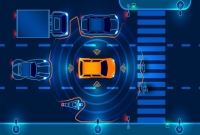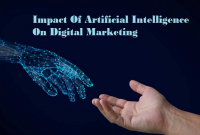
Defining Value in the IoT Space — 5 Marketing Approaches That Will Help
- By PRIYA --
- Monday, 24 Feb, 2020
Coined by many as “technology’s next Industrial Revolution,” the Internet of Things (IoT) will add greater complexity and intelligence to digital life as we know it. In fact, Marketo reports that over half of the world’s top global marketers expect IoT to revolutionize the marketing landscape by 2020. This, coupled with business leaders, vendors, and buyers all struggling to better understand the true impact of IoT services on their products and organizations signals that IoT will have a lasting impact across corporate and consumer landscapes.
For marketers of IoT, this buzz — coupled with the fact that, by 2021, more than 65% of midsize to large enterprises will use external IoT services for at least half of their solution building efforts (up from 35% today) — presents a unique opportunity to educate buyers, connect siloed decision-makers, and garner new mindshare. IoT marketers will play an important role in helping share and facilitate the expertise needed by these customers to overcome key deployment challenges such as privacy, standardization, and network integration.
From what we’ve observed, winning over customers in today’s highly fragmented IoT service marketplace requires a dedicated strategy focused on:
- Defining value as a best-fit provider
- Overcoming existing knowledge curves
- Building longstanding trust with consumers
Breaking Down IoT’s Key Vendors
Successfully marketing an IoT solution requires in-depth knowledge of the sector, in addition to the service provider landscape and its diverse user-base. As detailed by Gartner, “the IoT service provider market encompass a broad mix of providers, including but not limited to advisory consulting firms, system integrators, software providers and communications service providers as well as OT providers. The market is fragmented, however, driven by parallel alignment that exists between provider expertise and end-user IoT solution deployment. As providers gain stronger expertise, we will begin to see leaders and fast followers.”
When it comes to the IoT product landscape, there are four key sectors, which industry expert and CEO of Content 4 IT, Aaron Goldberg, has broken down for us:
- Endpoints, Sensors, Remote Devices: These are the little ‘things’ that actually form connections and capture data, such as accelerometers, gyroscopes, and thermometers.
- The Communication Network: IoT devices communicate with each other and external machines via the Communication Network. As this network advances we should expect to see its migration to 5G.
- Data Storage & Access Solutions: These solutions help store and archive data created from sensors or what is captured from the Communication Network. There is an infinite amount of data in IoT, and storage vendors help process and house this information.
-
Data Management & Processing Solutions: Management and processing vendors organize and sort through IoT data to produce detailed insights, trends, and outcomes.
As advanced IoT capabilities propel more intelligent business decisions, new entrants are expected to emerge and foster greater cilities apabor providers and technologists to leverage.
Here are five ways for marketers across the IoT landscape to break through and drive sustainable growth from B2B and B2C customers:
1. Make A Case For Continued Success
A brand’s messaging must be long-term — not one-and-done. This rings especially true for emerging technologies like IoT. In such a fast-paced industry, marketers must understand that there is plenty of confusion and uncertainty about how to actually go about implementing IoT technology. This presents an opportunity to drive conversations as a thought leader and convince partners and customers to invest in IoT development for future success.
2. Bridge Gaps Between Partners and Customers
In an industry with many moving parts, it can be hard to decipher how separate solutions, platforms, vendors, and even customers come together.
There are two main ways vendors can typically approach this: through an open API or via vendor proprietary standards (VPS). Vendors look for partners that connect in a similar way. For IoT marketers, these different paths present an opportunity to help bridge the gap in potential marketplaces or ecosystems. Deciding whether to go with an API or VPS is a strategic decision for an organization which will involve not only the IT department, but other functions and even the C-level.
Partners aside, remember that customers are the driving force behind purchases. For them, orchestrating a full IoT solution can be a daunting and arduous process that involves significant research and oftentimes building a proprietary solution without direction. This scenario is another opportunity to invest in educational marketing initiatives that empower and draw partners and customers together when using your solution.
3. Remember—Sensors Are Everywhere
Remember our first category of IoT vendors? The Endpoints, Sensors, and Remote Devices? These pieces of hardware are everywhere and continue to benefit from massive investment across healthcare, agriculture, retail, and many other industries. IoT is built around billions of data collectors with nearly unlimited battery life and machine-level intelligence capabilities. in other words, this industry is not only here, but it’s here to stay.
Even if companies haven’t fully developed platforms or strategies that take advantage of IoT, providers are finding new and exciting ways to implement these sensors into everyday life at lightning speed. With so many opportunities for IoT success, IoT marketers should cast a wide net of content to increase their relevance in the marketplace.
4. Stress The Immediacy Of Vendor Decisions
IoT is the epitome of ‘Big Data’—an industry that converges real-time analytics, huge quantities of data, and machine learning insights. As similar as the two may seem, IoT is actually quite different from IT. Simply put, it’s much more complicated and complex, which means marketers must seek to make a big impact when communicating with potential clients. Traditional tech vendors may be used to longer activation periods for large-scale IT initiatives, and as an IoT marketer this is your chance to stress the immediacy of vendor decisions in order to remain competitive in the marketplace.
5. Move Beyond Buzzwords To Results
At the end of the day, marketers must move beyond flashy buzzwords and focus on tried and true business outcomes. Clients want to know what they’ll gain when partnering with your organization, and it’s a marketer’s responsibility to help show how the relationship will be mutually beneficial. Focusing on strategic initiatives will also help catalyze conversations with a wide group of stakeholders at an organization, from IT to C-level. As a marketer, if you’re not talking to the right people, you’re fighting an uphill battle. Show measurable success and results, however, and you’re in a position to win.
IoT is a fast-paced, constantly changing industry, but that doesn’t mean there aren’t opportunities for savvy marketers. With the right strategy and tools in place, IoT marketers can truly compete and lead this exciting space.






